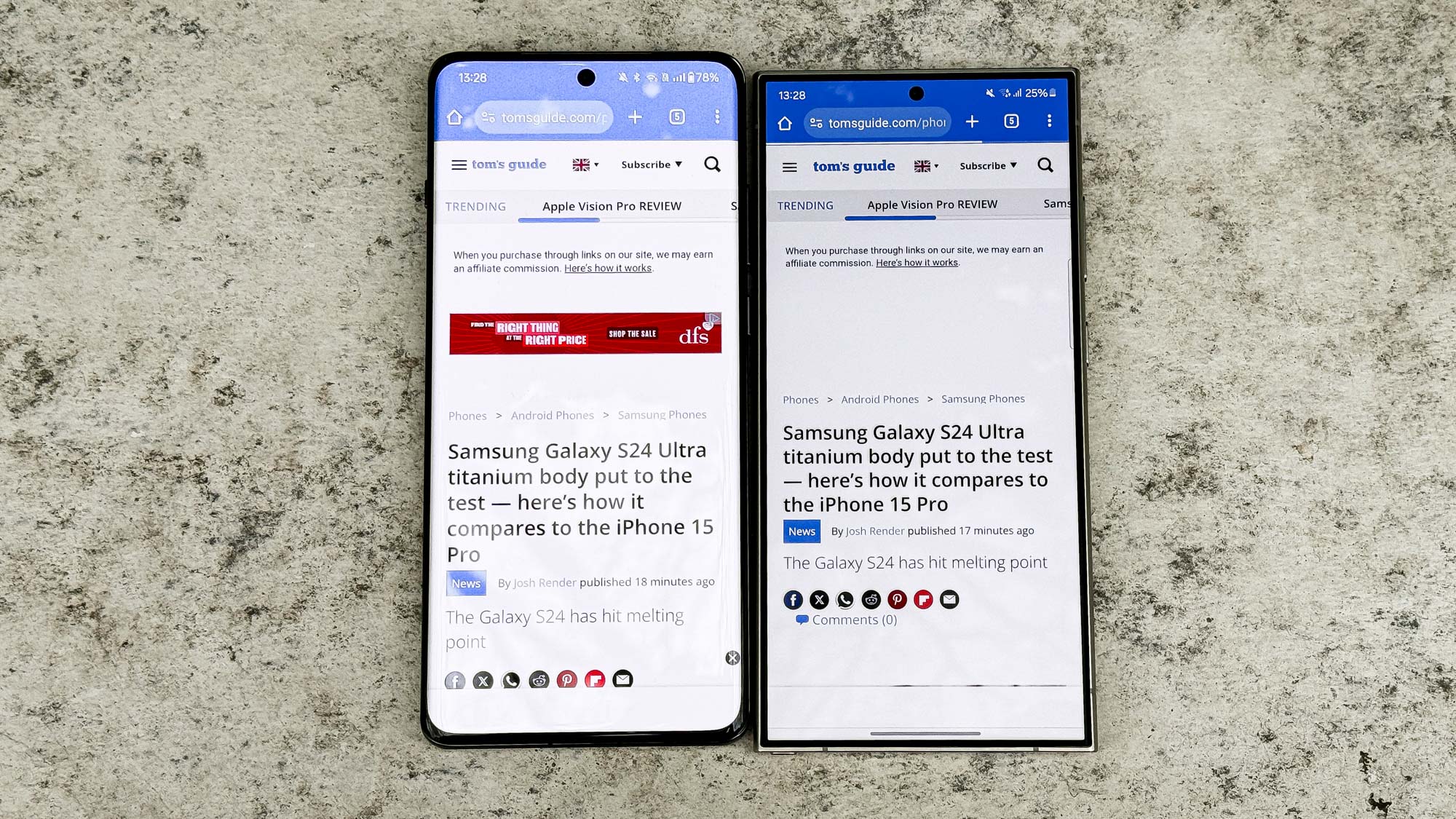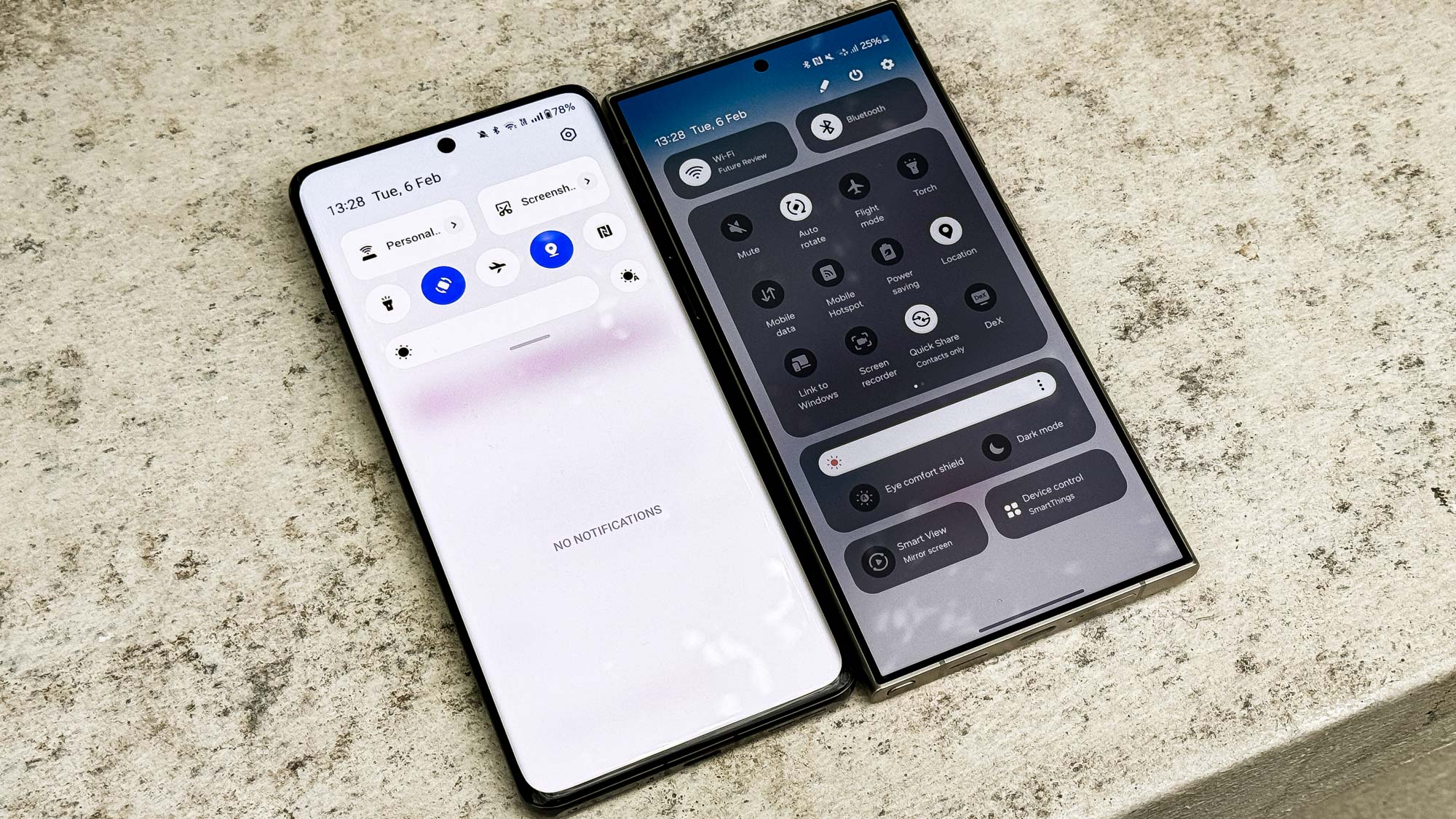I compared the OnePlus 12 and Samsung Galaxy S24 Ultra's display performance — and this is what I found
Is greater display brightness or an anti-glare screen better?

With the front of modern smartphones being all screen, all the time, having the best display amongst its rivals is an achievement worth broadcasting. The only issue is when, as the Samsung Galaxy S24 Ultra and OnePlus 12 are experiencing right now, you have two different devices trying to claim the throne.
These phones' displays aim to stand out, but in different ways. Samsung has currently got exclusive use of Corning's new Gorilla Armor Glass screen material, which promises to be more scratch-proof than ever, as well as reduce glare, making on-screen content more visible.
OnePlus meanwhile with what it claims to be the brightest display on a smartphone to date, with a peak brightness of 4,500 nits according to OnePlus' own measurements. For reference, the Galaxy S24 Ultra's official rating is 2,500 nits.
However, having tried and tested these two phones myself and via the TG laboratory, we can see that the situation's more complicated than it first appears.
Brightness
Before going into how bright these screens are, a small detour. We haven't tested the durability of the Galaxy S24 Ultra's display, which has supposedly been upgraded by the new glass, for ourselves. However, as it's the first phone to scratch at a Mohs level 7 instead of a level 6 in JerryRigEverything's smartphone durability test, it feels like Samsung and Corning's claims are true to some degree.
But back to to brightness. Taking the two phones outdoors on a sunny day (sunny for the U.K. in February anyway), I initially found that at automatic brightness, the OnePlus was dimmer. But once I set both to their maximum brightness, the OnePlus was undoubtedly the brighter phone.

Even with the Samsung phone's Extra Brightness setting enabled, the OnePlus still won. Activating this mode requires disabling the S24 Ultra's auto brightness as well, which leaves you to look after adjusting the brightness of the S24 Ultra yourself. Perhaps handy for boosting the screen's visibility in a pinch, but not a setting you will want to use all the time for the sake of your sanity or your phone's battery.
Sign up to get the BEST of Tom's Guide direct to your inbox.
Get instant access to breaking news, the hottest reviews, great deals and helpful tips.
Lab tests
However, we have to note that in lab tests, the Samsung scored a higher peak brightness, even though to the naked eye and both manufacturers' official specs, the OnePlus' display is higher. This is a weird discrepancy, and perhaps due to how the screens react to natural light versus direct flashlight light, or the precise method of testing we and OnePlus have used.
| Row 0 - Cell 0 | OnePlus 12 | Samsung Galaxy S24 Ultra |
| Color accuracy (∆E, lower is better) | 0.2 | 0.23 |
| DCI-P3 color gamut coverage (%) | 78.9 | 84.9 |
| Peak brightness (nits) | 1,115 | 1,363 |
As the table of results above shows, the OnePlus 12 does win on color accuracy when comparing the two phones' default color profiles. The Galaxy S24 Ultra also wins on color gamut coverage, though neither of these are things you are likely to notice with the naked eye.
Glare and reflections
One thing you can see when looking over the photos again is that the screen glare is less obvious on the Samsung. Even though it isn't as bright, it's definitely more readable.

Even when you hold the phones at weird angles — ones you're probably never going to naturally try and read or watch the screen from —, and even with the brightness noticeably lower than maximum, the Galaxy S24 Ultra tones down the reflections and bright spots. The side-effect is a noticeably darker-tinted screen, but that's a small price to pay.
Having gone through these results, the Galaxy S24 Ultra's display is probably my personal favorite. The OnePlus 12's screen is by no means bad, but however much additional brightness it can offer me over the S24 doesn't match up to a display that's designed to reduce outside interference.

These are two very good phones, with high-quality screens that are a delight to scroll through social feeds or watch streaming video on. Plus the rest of these devices' features are great too, as we cover in our full OnePlus 12 vs. Samsung Galaxy S24 Ultra comparison. But hopefully if you were considering upgrading to a leading Android phone in the near future, you've got a better idea of how these two best displays actually work in practice, and whether you'd rather have more nits or less reflections on your next phone.
More from Tom's Guide

Richard is based in London, covering news, reviews and how-tos for phones, tablets, gaming, and whatever else people need advice on. Following on from his MA in Magazine Journalism at the University of Sheffield, he's also written for WIRED U.K., The Register and Creative Bloq. When not at work, he's likely thinking about how to brew the perfect cup of specialty coffee.
